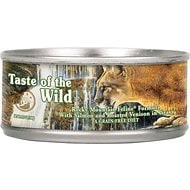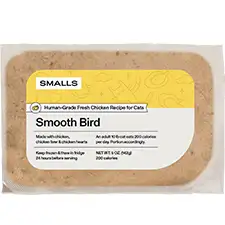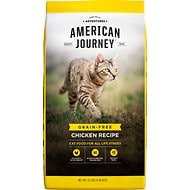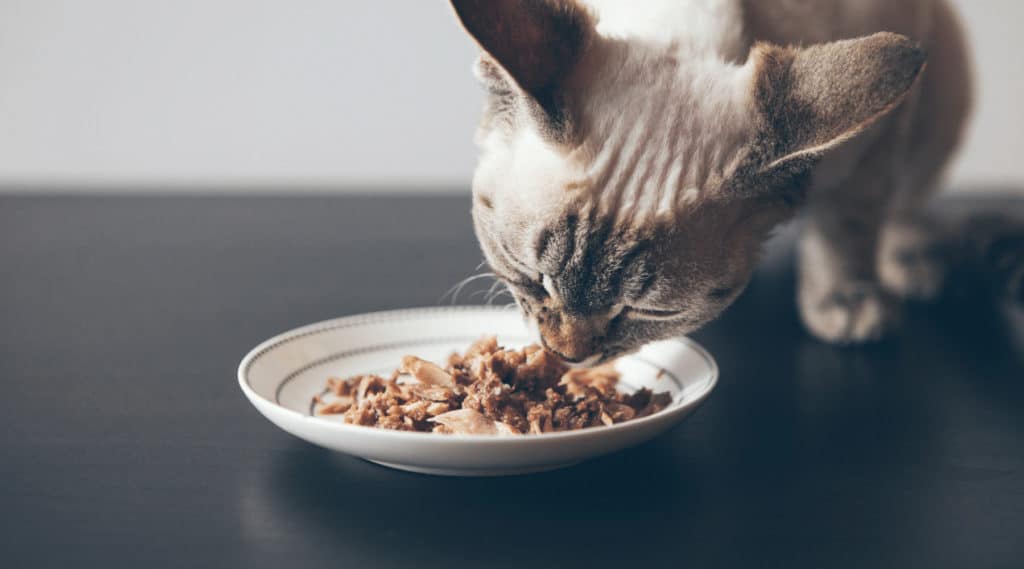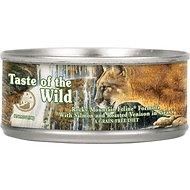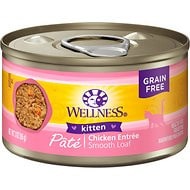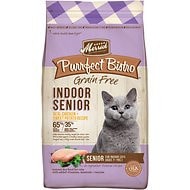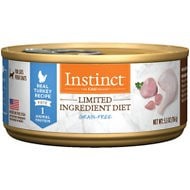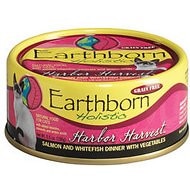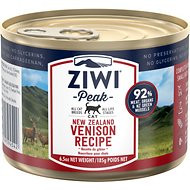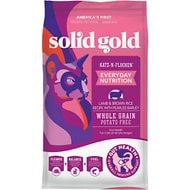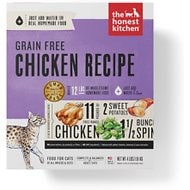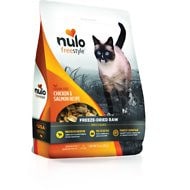Contents
- What Is The Best Cat Food Without Corn, Wheat Or Soy?
- Corn, Wheat, and Soy in Cat Food
- Are All Grains Bad for Cats?
- What Should You Look for in a Healthy Cat Food?
- How Do We Make Cat Food Recommendations?
- The 11 Best Cat Foods Without Corn, Wheat, or Soy
- Smalls Human-Grade Fresh Bird Cat Food
- Taste of the Wild Rocky Mountain Grain-Free Canned Cat Food
- American Journey Chicken Recipe Dry Food
- Wellness Complete Health Kitten Formula Grain-Free Canned Food
- Merrick Purrfect Bistro Grain-Free Indoor Senior Recipe Dry Cat Food
- Instinct by Nature’s Variety Limited Ingredient Diet Grain-Free Real Turkey Recipe Canned Food
- 5 More Top-Rated Cat Foods without Corn, Wheat, or Soy
- Earthborn Holistic Harbor Harvest Grain-Free Natural Canned Cat & Kitten Food
- Ziwi Peak Venison Recipe Canned Cat Food
- Solid Gold Katz-n-Flocken Lamb & Brown Rice Recipe with Pearled Barley Whole Grain Cat Food
- The Honest Kitchen Grain-Free Chicken Recipe Dehydrated Cat Food
- Nulo FreeStyle Chicken & Salmon Recipe Freeze-Dried Raw Cat Food
- Frequently Asked Questions
Whole grains are good for you, right? Things like whole-grain oats, whole wheat, and whole brown rice. Other grains like corn aren’t bad when they’re whole-grain, and some soy products offer health benefits.
What about your cat? Whole grains are complex carbohydrates which provide energy, dietary fiber, and essential nutrients. They are much more nutritious than processed or refined carbohydrates and they are fairly digestible in moderate amounts. With corn, wheat, and soy, however, it’s a different story. These grains offer limited nutritional value to cats and their quality in cat foods tends to be fairly poor. We personally avoid any cat food that contains corn, wheat, and soy ingredients because they are commonly used as fillers and don’t do your cat much good.
In this article, we’ll explore the subject of grains like corn, wheat, and soy in cat food to help you understand their role in cat food and how to identify them on a pet food label. From there, we’ll show you what you should be looking for in your cat’s food and provide you with our top picks for the best cat food without corn, wheat, or soy ingredients.
What Is The Best Cat Food Without Corn, Wheat Or Soy?
- Smalls Fresh Bird Cat Food Delivery
- Taste of the Wild Rocky Mountain Grain-Free
- American Journey Chicken Recipe Dry Food
- Wellness Complete Health Kitten Formula
- Merrick Purrfect Bistro Grain-Free Indoor
- Instinct by Nature’s Variety Limited Ingredient
- Earthborn Holistic Harbor Harvest Grain-Free
- Ziwi Peak Venison Recipe Canned Cat Food
- Solid Gold Katz-n-Flocken Lamb & Brown Rice
- The Honest Kitchen Grain-Free Chicken
- Nulo FreeStyle Chicken & Salmon Recipe
Corn, Wheat, and Soy in Cat Food
In cat food, corn has been a controversial ingredient for years. Not only is it difficult to digest, but it offers limited nutritional value in addition to being a common trigger for cat food allergies. Wheat is similar, especially in its most processed forms. Not only are both difficult for cats to digest, but they are often used as supplemental proteins in cat foods.
What’s the problem there? Plant protein simply isn’t as nutritious or as biologically valuable for cats as animal protein. But it’s more complicated than that.
Cats are obligate carnivores which means they have a biological need for meat in their diet. They do not possess the digestive enzymes necessary to break down carbohydrate, so they aren’t able to utilize simple sugars as a primary source of energy. They have short digestive tracts as well and no functional cecum, the part of an herbivore’s body that contains beneficial bacteria which help digest plant fiber. All of these things combine to make it very difficult for cats to digest plants.
But what about soy in cat food?
Pet food companies often use wheat gluten and corn gluten as supplemental sources of protein – soy protein is similar. All three are cheap fillers used as substitutes for the real meat your cat’s body needs for optimal health. You can see the problem.
In addition to the issues already mentioned for corn cat food and wheat in cat food, soy products have a specific impact on your cat’s body. Soy contains a compound called phytates which inhibits healthy mineral absorption and blocks the enzymes needed to digest protein. This causes inflammation of the GI tract which can lead to serious health problems. It also interrupts the function of the thyroid, the gland that controls the hormones that regulate metabolism and other essential functions.
By now you can understand the problem with corn, wheat, and soy in cat food, but you may be wondering whether other grains are bad for cats. Read on to find out.
Are All Grains Bad for Cats?
Think back to what we said about whole grains. Things like whole brown rice, whole-grain oats, and whole pearled barley are some of the most nutritious grains out there, for both pets and people.
However, when pet food manufacturers use by-products of the human food grain processing industry like wheat middlings, rice bran, corn gluten, and soybean hulls they don’t offer the same degree of nutrition. In fact, they may take the place of more nutritious ingredients like animal protein and increase the risk for triggering a food allergy or sensitivity. This is why you should look for a cat food without corn or wheat and avoid soy ingredients as well.
So, it’s probably best to feed your cat a grain-free diet, right? Not necessarily.
Grain-free cat food is simply cat food without grains, but that definition doesn’t tell the whole story. Instead of being able to use common carbohydrates like rice, pet food manufacturers use things like peas, legumes, and potatoes. The problem with these ingredients is that they tend to be high in protein which can raise the total protein content of the recipe, misleading the customer to think it’s a better option for their cat than it really is.
Legumes may be edible for people, but there is some concern about their impact on pet health. The FDA is currently investigating claims related to grain-free pet foods and an increased risk of dilated cardiomyopathy (DCM), particularly in dogs.
What about cats?
Legumes contain high levels of phytic acid which have a tendency to bind calcium, magnesium, and iron in animals. The lectin proteins in legumes can also be problematic because they are a plant’s natural defense system. Birds are able to digest these proteins, but carnivores cannot. They also attach to the villi lining the digestive tract, blocking the absorption of nutrients.
What Should You Look for in a Healthy Cat Food?
We highly recommend looking for a cat food without corn products and you should also avoid soy and wheat products as well. Don’t just jump for the nearest grain-free cat food however, because certain grain-free plant ingredients may be just as harmful. Your best bet is to start with a high-quality recipe made with a real source of animal protein as the main ingredient with limited content of highly digestible carbohydrates.
Here are some general things to look for in cat food:
- High in quality animal protein. Protein is the foundation of a healthy diet for cats, so look for a source of high-quality animal protein like meat, poultry, or fish as the first ingredient.
- Moderate content of animal-based fats. In the same way that animal proteins are more biologically valuable for your cat, so are animal fats. Look for things like chicken fat or salmon oil as primary sources with plant oils as supplemental sources of omega-6 fatty acids.
- Limited content of digestible carbohydrates. The lower the carbohydrate content of your cat’s diet the better and it needs to come from digestible sources like whole grains and vegetables.
- No generic by-products or artificial additives. Things like chicken by-product meal and beef by-products are not necessarily bad but avoid generic things like animal digest or meat by-product meal. Avoid artificial colors, flavors, and dyes as well.
- Complete and balanced nutrition. Make sure any food you choose for your cat is labeled “complete and balanced” according to AAFCO food nutrient profiles.
Now that you know what to look for in a good quality cat food, you’re ready to start shopping! Before you do, however, we want to clue you in to how we make our cat food recommendations so you know you can trust them for your cat.
How Do We Make Cat Food Recommendations?
Shopping for cat food can be confusing if you don’t understand what everything on the label means. Fortunately for you, we do! We’ve done a ton of research and have reviewed most of the highest quality pet foods on the market, so we know what we’re talking about.
Any cat food we recommend on this site has met our high standards for quality and safety. We’ve checked and double-checked to make sure real meat is the first ingredient (ALWAYS) and that the recipe contains other healthy, natural ingredients.
Here are some other requirements for a cat food recipe to receive our recommendation:
- A source of high-quality animal protein as the first ingredient
- At least 30% crude protein for kittens and at least 26% for adults
- A minimum of 9% crude fat for kittens and adults
- A balance of omega-3 and omega-6 fatty acids, primarily from animal sources
- A rich blend of nutrients from natural sources and supplements, as needed
- Limited carbohydrate content from digestible sources (like whole grains and veggies)
- No low-quality fillers, by-products, or artificial additives (preservatives, dyes, or flavors)
The 11 Best Cat Foods Without Corn, Wheat, or Soy
Your cat deserves the highest quality nutrition you can give him, so don’t skimp on price! Higher quality cat foods tend to be more expensive, but not all pricy cat foods are good (think Science Diet). That being said, you don’t necessarily need to spend a fortune on your cat’s diet – just feed the highest quality food you can consistently afford. Here are our recommendations:
| Our 2023 Picks: Best Cat Foods Without Corn, Wheat, or Soy | |||
Smalls Fresh, Human-Grade Chicken Cat Food
|
CHECK PRICE | ||
Taste Of The Wild Rocky Mountain Grain-Free
|
CHECK PRICE | ||
American Journey Chicken Recipe Dry Food
|
CHECK PRICE | ||
Wellness Complete Health Kitten Formula
|
CHECK PRICE | ||
Merrick Purrfect Bistro Grain-Free
|
CHECK PRICE | ||
Instinct by Nature’s Variety Limited Ingredient
|
CHECK PRICE | ||
Earthborn Holistic Harbor Harvest
|
CHECK PRICE | ||
Ziwi Peak Venison Recipe Canned Cat Food
|
CHECK PRICE | ||
Solid Gold Katz-n-Flocken Lamb & Brown Rice
|
CHECK PRICE | ||
The Honest Kitchen Grain-Free Chicken
|
CHECK PRICE | ||
Nulo FreeStyle Chicken & Salmon
|
CHECK PRICE | ||
Smalls Human-Grade Fresh Bird Cat Food
Our Top Overall Pick: When it comes to quality, fresh food is at the top of the list for most pet owners. Fresh food more closely approximates your cat’s natural diet than processed kibble and the quality is generally higher as well. Smalls is a fresh pet food company that we heartily recommend because they use only natural ingredients in their recipes and cook them in small batches to ensure quality and nutritional integrity. Choose from two cat food recipes (chicken or beef), both of which are free from grains including corn, wheat, and soy. They rely on fresh fruits and vegetables as nutritious sources of key nutrients. Simply provide some basic information about your cat’s breed, age, weight, and activity level to receive pre-portioned packages of fresh cat food customized to your cat’s calorie requirements.
Taste of the Wild Rocky Mountain Grain-Free Canned Cat Food
Most Popular Cat Food without Corn, Wheat, or Soy: Because there are hundreds of cat food brands out there, it can be difficult to choose one. We recommend Taste of the Wild as a popular option you can trust because they use premium animal proteins and other whole-food ingredients in all of their recipes. This Rocky Mountain Grain-Free Canned Cat Food features fresh salmon as the main ingredient with fish broth and chicken broth for natural flavor and moisture. Chicken liver, fresh chicken, smoked salmon, and roasted venison offer supplemental protein as well as healthy fats, balanced with sunflower oil as a source of omega-6 fatty acids. This recipe also contains fresh fruits and vegetables as natural sources of key nutrients with no corn, wheat, or soy ingredients.
American Journey Chicken Recipe Dry Food
Most Affordable Cat Food without Corn, Wheat, or Soy: Affordable cat food doesn’t have to be low in quality and this American Journey Chicken Recipe Dry Food is an example of that. Made with fresh chicken and chicken meal as the top two ingredients, this recipe is packed with real animal protein and natural poultry flavor. Chicken fat provides a nutritious source of essential fatty acids while flaxseed and menhaden fish meal supply omega-3 fatty acids. You’ll find fresh fruits and vegetables like apples, spinach, blueberries, and carrots to provide natural sources for key nutrients with cranberries for urinary health. This recipe is free from grains including corn, wheat, and soy with tapioca starch as the primary carbohydrate. It does contain some pea protein, but four animal proteins come before it, so it may not significantly contribute to the 40% protein content.
Wellness Complete Health Kitten Formula Grain-Free Canned Food
Best Kitten Food without Corn, Wheat, or Soy: Formulated to support the nutritional needs of growing kittens, this all-natural recipe features real chicken as the first ingredient to support healthy muscles. It also supports the five signs of kitten wellness: lustrous skin and coat, healthy digestion, bright eyes and strong teeth, high energy, and healthy immune system. This formula is loaded with natural sources of antioxidants and balanced with essential vitamins and minerals. It contains a rich blend of omega fatty acids with added taurine to support your kitten’s growth and development. Best of all, it is free from corn, wheat, and soy.
Merrick Purrfect Bistro Grain-Free Indoor Senior Recipe Dry Cat Food
Best Senior Cat Food without Corn, Wheat, or Soy: As your cat starts to get older, he may not need as many calories but his needs for high-quality animal ingredients stays the same. This Merrick Purrfect Bistro indoor senior recipe features 65% animal ingredients in a complete and balanced formula. It contains healthy antioxidants and essential nutrients from wholesome, natural ingredients including a rich blend of omega-3 and omega-6 fatty acids. This recipe contains no corn, wheat, or soy ingredients and is completely free from grains and by-product meals. It features deboned chicken as the first ingredient with chicken meal and turkey meal as supplemental proteins. Overall, it contains 38.5% protein and 12% fat at 353 calories per cup.
Instinct by Nature’s Variety Limited Ingredient Diet Grain-Free Real Turkey Recipe Canned Food
Best Cat Food without Corn, Wheat, or Soy for Sensitive Stomach: Many cats have sensitive stomachs but may not have allergies. In many cases, cat food allergies are to common proteins like chicken, beef, and fish as well as dairy products. Grain allergies are less common but low-quality grains like corn, wheat, and soy can be a problem of their own. If your cat has a sensitive stomach or you suspect food allergies, a limited ingredient diet may be a good choice. This Real Turkey Recipe Canned Food from Instinct by Nature’s Variety is a great choice because it features a single source of real animal protein with no grains and no artificial additives. It contains a limited number of main ingredients to reduce the risk for triggering an allergy and is highly digestible.
5 More Top-Rated Cat Foods without Corn, Wheat, or Soy
Earthborn Holistic Harbor Harvest Grain-Free Natural Canned Cat & Kitten Food
If you’re looking for a wholesome recipe formulated for both kittens and adult cats, look no further than this Earthborn Holistic Harbor Harvest recipe. It features high-quality animal protein from digestible tuna and salmon to support growing muscles and to help your adult cat maintain lean mass. A rich blend of omega-3 and omega-6 fatty acids support healthy skin and coat while vitamins and chelated mineral supplements ensure complete and balanced nutrition.
Ziwi Peak Venison Recipe Canned Cat Food
This Ziwi Peak Venison Recipe Canned Cat Food is a great option if you’re in the market for a high-protein, low-carbohydrate cat food. It features 100% single-sourced venison as the main ingredient with nutritious organ meats like tripe, liver, lung, and heart. Chickpeas are the only carbohydrate ingredient and New Zealand green mussels act as a natural source of joint-supporting glucosamine and chondroitin.
Solid Gold Katz-n-Flocken Lamb & Brown Rice Recipe with Pearled Barley Whole Grain Cat Food
Whole grains are just as nutritious for cats as they are for people, though you should still limit the content in your cat’s food. This Solid Gold Katz-n-Flocken Lamb & Brown Rice Recipe contains whole grains like brown rice and pearled barley but still features real lamb and chicken meal as the main ingredients. This formula also contains fresh fruits and berries as natural sources for key nutrients with probiotics for healthy and regular digestion.
The Honest Kitchen Grain-Free Chicken Recipe Dehydrated Cat Food
To approximate the nutritional quality of fresh food without sacrificing the convenience of dry food, consider this The Honest Kitchen Grain-Free Chicken Recipe. It is gently dehydrated to make it shelf-stable but doesn’t subject the ingredients to high heat processes. It features free-range chicken as the main ingredient with eggs as a supplemental source of protein. Sweet potatoes, flaxseed, pumpkin, spinach, and cranberries act as natural sources for key nutrients with chelated minerals for balance.
Nulo FreeStyle Chicken & Salmon Recipe Freeze-Dried Raw Cat Food
If you want something even higher in quality than the previous recipe, try this Nulo FreeStyle Chicken & Salmon Recipe Freeze-Dried Raw Cat Food. It features real chicken and salmon as the main ingredients with nutritious chicken necks, heart, and liver as supplemental sources of protein and raw bone. Salmon oil provides a rich source of omega-3 fatty acids with spinach and cranberries for key nutrients. This recipe is freeze-dried raw which means it preserves the nutritional integrity of the raw ingredients, making it a healthy recipe for your cat.
Frequently Asked Questions
- What cat food ingredients should I avoid? The thing you need to remember is that cats are obligate carnivores, so their bodies simply are not evolved to digest plant foods. Your cat’s diet should be protein-based with moderate amounts of fat and as little carbohydrate as possible. Any carbohydrates in your cat’s food need to come from high-quality, digestible sources like whole grains and vegetables. Generally speaking, you should avoid corn, wheat, and soy ingredients as well as by-products of unknown origin (things like animal digest or poultry by-product meal). You should also avoid artificial additives like colors, flavors, and dyes.
- What are byproducts in cat food? The Association of American Feed Control Officials defines byproducts as, “secondary products produced in addition to the principal product.” Essentially, by-products are the leftovers after the desired product has been extracted or processed. In pet foods, this may include things like bran or hulls from whole grains and feet, skin, and organs from poultry. Not all by-products are inherently bad, but you should be cautious about trusting a product that incorporates more by-products than whole ingredients. You should also avoid generic by-products from meat or poultry instead of beef or chicken.
- Is grain-free cat food good for my cat? There is no simple yes or no answer to this question. If your cat is allergic or sensitive to grains, grain-free cat food may be the best option. Otherwise, however, grains (specifically whole grains) can be a nutritious addition to your cat’s diet in low to moderate amounts.
- Where can I find a cat food without corn, wheat, or soy? The good news is that most high-quality pet food companies don’t use corn, wheat, or soy products in their recipes. Just because a brand has a popular reputation and a wide product selection, however, doesn’t mean you can trust it. Brands like Purina and Science Diet that have a huge following and a long history in the pet industry make heavy use of these ingredients. You need to do your own research and check the ingredients list before you buy.
- What ingredients are better than corn, wheat, and soy? If your cat is allergic to grains, you should be looking for nutritious alternative sources. Try to avoid cat foods that make heavy use of peas, legumes, and potatoes. Fresh vegetables are a better alternative. Keep in mind as well that cats have no biological need for carbohydrates in their diet, so a no-carbohydrate recipe may be even better as long as it is nutritionally balanced. Fresh vegetables are a natural source of key nutrients, however, so it is better to choose a recipe that contains some vegetables than one that relies entirely on synthetic supplements.
The cat food industry is huge and there are hundreds of products to choose from. Many of these products have excellent ratings on pet food retail sites like Chewy, but you can’t necessarily trust those ratings. Just because a pet likes a food doesn’t necessarily mean it’s good for them and some of the most popular brands on the market make heavy use of low-quality ingredients like corn, wheat, and soy products. If you’re looking for a cat food without corn, wheat, or soy you still have plenty of options, but you’ll need to spend a few extra minutes reading pet food labels to find them.
If you’re really not sure where to start, you can always try one of our recommendations above. We’ve also explained how we make those recommendations, so you know you can trust them!

